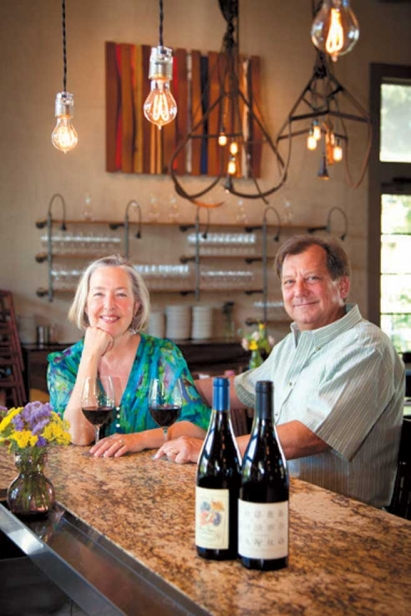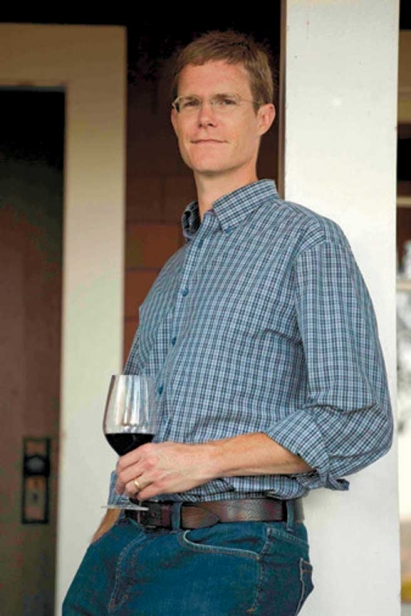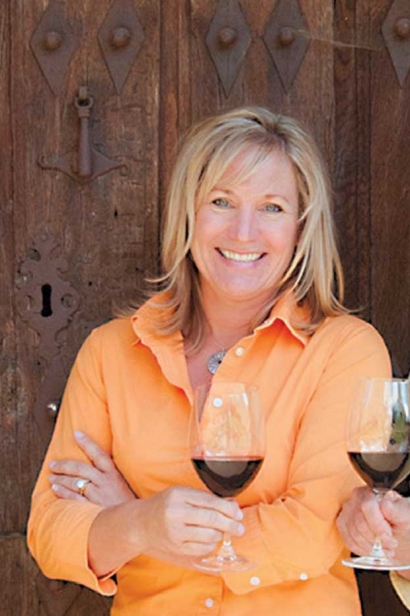Cabernet Franc: Our Love Affair with Cabernet Sauvignon's Papa!
As wine merchants, we enjoy introducing clients to varietals they are not familiar with and allowing them to just maybe find a new favorite!
In 2012, Cabernet Franc, commonly referred to as “Franc,” was one of our top-selling varietals, a close second to Cabernet Sauvignon. Many do not realize that Cabernet Sauvignon originated as a cross between Franc and Sauvignon Blanc. Franc ripens earlier than its Cabernet Sauvignon progeny, and is better suited to cooler climes. Franc performs well in stone and chalky soils, as well as in sandy terroir. Not as fleshy as Merlot and with less tannic structure than Cabernet Sauvignon, this deeply colored, thin-skinned grape offers floral, plum, blackberry, cassis, spice and fresh herb flavors when ripe. Before it is fully ripe, it’s possible to find green pepper or other green vegetal aromas.
Franc is believed to have been established in the Libournais wine region of southwest France sometime in the 17th century after Franc vine cuttings were transported to the Loire Valley.
We asked four of the top winemakers producing Napa Valley Franc about this grape and the reasons they were drawn to make wine from it, the unique challenges of making a Franc, the differences and similarities they find between a Bordeaux-style Franc and what they are making in the Napa Valley, if there are any notable trends in the market for Franc and, especially for this local-dairy-focused issue of Edible Marin & Wine Country, their favorite local cheese to enjoy with their wine.
We hope you enjoy their stories, and their Franc wines!
John and Tracey Skupney, Lang & Reed Wines
Both Tracey and I were schooled in classic European wine before emigrating to the Napa Valley in 1980. Thus, we were aware of the charms of Franc from the Loire Valley, as well as what part it played in the Bordeaux blending puzzle. In the cellar and from barrel we found that Napa Valley Franc seemed to express itself at an early stage—both aromatically and flavor-wise. It was this early charm that attracted us to explore Franc fashioned on its own, at 100%, beginning in 1993.
Every varietal has its own set of characteristics and challenges and Franc is no different. In making Franc I ascribe to a “less is more” approach and seek to bring forth nuance and subtly over power or density. There is a tipping point for Franc: On-the-vine vegetative characteristics mature into herbaceous; capturing just the right amount of those herbaceous aromatics and flavor helps express the charm and inherent nature of Franc. The herbaceous qualities, along with the supporting acid, are components that make Franc an amazingly versatile wine with a broad variety of foods.
We cannot replicate Chinon or St. Emilion here, nor can the French emulate Napa Valley over there. Each expresses its own set of circumstances, that combination of soil, aspect and climate.
With Franc, we enjoy a little more sun and, usually, a more stable growing season, so [Napa Valley] Franc generally shows more bravado and opacity than counterparts in the Loire, which are often a little more racy and sinewy. As for Bordeaux, it is difficult to assess purity of Franc character as the grape is a bit of a chameleon, taking on the characteristics that are brought to it by other varieties and few wines in the region contain much Franc. It is a critical addition for aromatics and supporting structure, but rarely the lead player. Similarities are more likely found in the best cuvee, or lieu dit (single site) bottlings from the Loire, where the floral aromatics are accented by herbaceousness and a solid beam of cherry-blueberry fruit is present.
Nowadays there are many more people who have experienced a broader selection of Franc than a decade ago, both domestic and imported. The very bright side is that there is a whole new generation of wine lovers who are far less “set in their ways,” who revel in the differences in flavor and experiences that include Franc. The continuing food revolution, which includes the “snout-to-tail” ethos, has also provided plenty of goodies that traditionally match so well with Cabernet Franc, such as rillettes (traditionally prepared with pork). Franc is really the “conservatively compassionate” grapevine in the fact that, in the spring, it is a mid-season bloomer and, at harvest, a mid-season ripener—avoiding frosts in the spring and inclement weather in the fall.
Lang & Reed Two-Fourteen, Napa Valley 2009, pairs beautifully with Cypress Grove’s Humboldt Fog or Andante’s Acapella, both goat milk cheeses.
Tom Garrett, Detert Family Vineyard
It was my love for our family’s vineyard that inspired me to make wine. Fortunately, regarding Franc, I didn’t have much choice in the matter. The vineyard was already planted almost entirely (95%) Franc! Robert Mondavi began working with the Detert grapes in the 1950s when we sold them to Charles Krug Winery. When he left
Krug to establish Robert Mondavi Winery in 1966, we moved with him. It became a core of the Robert Mondavi Reserve Cabernets and the early Opus One wines. He told my grandfather, Gunther Detert, that he did not want him to plant anything else in the vineyard. And to make that palatable for my grandfather, he said he would pay the same price for our Franc as he paid for his highest priced Cab lots.
The key to Franc is location. Our vineyard is ideal for Franc because of its very deep, well-drained alluvial soils and the mild climate of the west side of Oakville. We experience no unusual difficulties. We pay close attention to vine and soil health, canopy management and sun exposure during the growing season. But in many ways, our site makes our job easy. We get ripe flavors, phenolic development and concentration even in challenging years. Franc from lesser sites, where drainage is poor or sun exposure is not optimal, can make pleasant wines, but never anything compelling.
The similarity through all of these regions is Franc’s herbaceous notes, plush texture and powerful aromatics. Franc from the Loire tends to have more herbal flavors, higher acidity and lower alcohol. From Bordeaux and Napa Valley it is typically more stylistically similar. Winemaking decisions also have an impact. The Francs of California, with our abundance of sun and relatively long, dry growing season, tend to have more richness, ripe fruit flavors and less herbaceousness than those of Bordeaux or Chinon.
Yes, there is a passionate, and very vocal, group of wine lovers and winemakers who believe that Franc is the most compelling of the Bordeaux varieties. Franc has long been a niche wine but recently has enjoyed increased interest. Franc is becoming more accepted by wine buyers and sommeliers because of its versatility with foods. For a sommelier, recommending a wine to pair with wide range of dishes, Franc is often a wise choice.
Vella Cheese Company’s Dry Jack Special Reserve is a favorite with my Detert Cabernet Franc 2008.
Pam Starr, Crocker & Starr
The spice and floral aromas of Franc inspired me to seek and master the secrets of growing and capturing those components in a concentrated and juicy wine.
One of the big challenges to Franc is to coax the grape from “green characters” to “blue characters.” I start in the
vineyard, with the timing of when to manipulate the canopyto-cluster ratio. And then, later in the season, with timing the pick—sometimes hang time means just more sugar.
Differences between Franc from Bordeaux, the Loire and Napa? Goldilocks and the three bears, for sure... the Loire is too cold, Bordeaux is too blended and Napa Valley is just right!
Single vineyard and single clones of really delicious Franc are more available now. In the past year, I’ve enjoyed going to Franc-only tastings, as the assumption is that most of the wines poured will be extremely enjoyable. This was not the mindset just five years ago.
Napa’s Goat’s Leap makes a goat milk cheese called Sumi that is my choice with Crocker & Starr Estate Cabernet Franc 2009.
Aaron Pott, Pott Wines
I first worked with Franc as the assistant winemaker to John Kongsgaard at Newton Vineyard in 1990. There was a great Franc vineyard there called Front
Gate that was planted on fluffy volcanic ash. The wine that it produced was so beautiful and so intense that I fell in love with it. At the same time, Kongsgaard introduced me to his high school roommate, Dade Thieriot. Thieriot’s family had owned the San Francisco Chronicle and he was a prodigious collector of great wines—mainly French and German. Thieriot would often visit Napa and bring along amazing St. Emilion and Pomerol that had a strong Franc component. These wines were a revelation for me and made me think more and more about Franc. My third Franc mentor was Michel Rolland, who was the consultant at Newton at the time. Through John I learned how to make and grow Franc. Through Dade I learned what great Franc should taste like. Through Michel Rolland I further refined my technique and this is what got me a job in St. Emilion.
Franc is an older Bordeaux variety and it is said that it is closer to its wild parentage. Vines that are more closely related to wild vines are generally more sensitive to the terroir in which they are grown and show more of the characteristics of the specific terroir. It shows all of the faults of the terroir if it is planted in the wrong location. It loves well-drained soils and thrives on both great valley floor sites and super hillside sites in the Napa Valley.
In the last 20 years, as our planet warms, the differences between the Franc wines of Bordeaux, the Loire and those of Napa Valley have lessened. The Loire has traditionally produced a very aromatic wine of medium body that highlights the greener spectrum of aromatics that Franc has to offer—the pepper and green tobacco characters. These wines are often offputting to people who love Napa or Bordeaux wines, because they are greener and they don’t have the body and depth of the latter wines. What the Loire has is elegance and complexity. The high acidity of the Loire wines makes them great wines with food.
Bordeaux is the “great lie” of Franc. There, with few exceptions, Franc is considered a blending grape and is generally planted on the least favorable soils in all the appellations. There is only a small area where Franc reaches its greatest heights and this area is so important that it makes us think that Franc is one of the most important grapes in the wine pantheon—the roughly one square kilometer area of St. Emilion and Pomerol. The gravel plain that runs along the border of these two great regions produces some of the best Franc in the world. These wines are insanely complex, very powerful and über-long lived. They, for me, are among the greatest wines that the world has to offer. They highlight the classic fruit components of Franc: blueberry, red currants, violets and raspberry, and display the spice and earthy components as well with cedar, nutmeg, cinnamon, tobacco and black truffle notes.
The Franc wines of Napa, grown on the great sites which are very rare, have characteristics similar to those of the great wines of St. Emilion and Pomerol, but in some cases with greater density and velvety smooth tannins.
I think that we are starting to see different styles emerging from Napa as people discover their own personal terroir and we are seeing many new variations from new plantings. Franc is a grape of passion and takes a serious commitment and will always produce something different than we thought it would! As the vines come of age in Napa I think we are poised to seize the crown from our European counterparts and create wines with great quality and a great sense of place.
Pott Wines La Carte et le Territoire, Young Inglewood Vineyard, St. Helena 2010, pairs beautifully with Barinaga Ranch’s sheep milk Barinaga Txiki.








